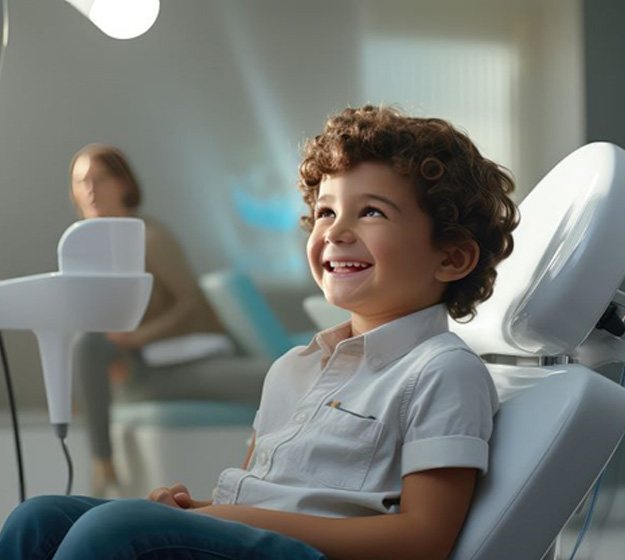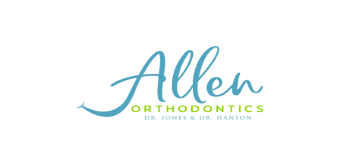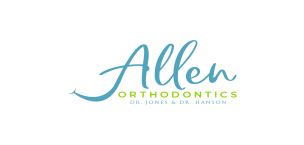Phase 1 Pediatric Orthodontics – Allen, TX
Prepare Your Child’s Smile for Life
If we told you that you could dramatically shorten the amount of time your child needed to spend in braces, would you start your child on this treatment? Most parents respond with a resounding “Yes!” With Phase 1 Pediatric Orthodontics in Allen, TX, that’s exactly what we are suggesting. This service allows Dr. Jones and Dr. Hanson to address orthodontic problems in the earliest possible stages so future ones can be lessened or avoided entirely. According to the American Association of Orthodontists, you should bring your child in for an orthodontic screening starting at age seven. Allen Orthodontics is happy to offer FREE consultations for new patients, so schedule an appointment or give us a call today!
Why Choose Allen Orthodontics for Phase 1 Pediatric Orthodontics?
- Reduce the Need for Future Orthodontic Treatment
- Warm and Friendly Orthodontists and Team Members
- In-Network with Almost All PPOs
How Phase 1 Pediatric Orthodontics Works
One of the main goals of Phase 1 Pediatric Orthodontics is to solve minor misalignment issues in baby teeth. This gives adult teeth the best chance of coming in straight. Baby teeth essentially set the path for adult teeth, which means if they are crooked or crowded, adult teeth will be as well.
Phase 1 only requires oral appliances to be worn when the child goes to bed. This allows Dr. Jones and Dr. Hanson to create more space between the baby teeth so the adult teeth have enough room to erupt as intended.
We can also help break bad habits your child might have, including thumb-sucking or tongue thrusting. Both of these can negatively impact their future oral development. As a result, we can help parents save a lot of time and money on correcting orthodontic problems later.
Benefits of Phase 1 Orthodontics

- Shorter Treatment Length: When children complete Phase 1 Orthodontics, they typically need less orthodontic care entirely. This helps parents save time and money on future services.
- Function Made Easy: Once the baby teeth are aligned, we can stimulate proper oral development and enable the child to speak, eat, and smile as comfortably as possible. This also helps the child avoid chronic pain in the jaw and face.
- Opened Airway: Part of the treatment process involves increasing the size of the child’s airway, allowing them to breathe better during sleep. The list of benefits it can provide is quite endless. Children that are properly rest have better focus, memory, and have fewer behavioral issues.
- Better Confidence: Straightening the baby teeth gives the child a more attractive smile that will likely help them feel better about themselves in school and with friends. This can be a huge boost to their mental health and well-being.
Phase 1 Orthodontics FAQs

Our Allen orthodontics team is ready to set your child up for a lifetime of healthy smiles. Before you bring your little one in for a consultation, however, you may want to know more about the Phase 1 Orthodontics process. Below, you will find answers to some frequently asked questions. If your specific questions are not addressed here, give us a call. We will be pleased to speak with you.
When Does Phase 1 Orthodontics Take Place?
Phase 1 Pediatric Orthodontics, which you may hear referred to as interceptive orthodontics, usually occurs when a child is 6 – 9 years old. It is usually in this age range that children start to lose their baby teeth and develop their first permanent teeth. Therefore, it is the ideal time for orthodontists to diagnose disturbances in jaw growth and other issues that are best addressed when a child is still quite young. The American Association of Orthodontists recommends that all children get an orthodontic checkup before they reach the age of 7.
What Issues Can Phase 1 Orthodontics Address?
Treatment is designed to address a number of tooth and jaw problems while they are still early in their development. For example, it can help to prevent or fix overcrowding, large spaces between the teeth, protruding teeth, or the early/late loss of baby teeth. It can also play a role in resolving underbites, overbites, and other forms of malocclusion (bad bite). Successful Phase 1 treatment can do much to prevent future problems and guide the development of incoming permanent teeth.
What Appliances Are Used in Phase 1 Orthodontics?
A few appliances that are sometimes used in Phase 1 Pediatric Orthodontics include:
- Palate expander. This is a device that gently widens the upper jaw to create more space for the teeth and promote a healthy airway.
- Space maintainer. When a child loses a baby tooth too early, a space maintainer can keep the space open until the new permanent tooth comes in.
- Braces may be placed only on select teeth (not the whole mouth).
- Herbst appliance. With the help of steel crowns on the molars, a Herbst appliance can help to correct a malocclusion.
- A retainer is usually necessary in order to maintain the results of Phase 1 treatment.
Is Phase 1 Orthodontics Painful?
Some discomfort is to be expected as a child is adapting to their new appliance. However, this usually wears off quickly as the patient gets used to the way the treatment feels in their mouth. Over-the-counter pain relievers and cold compresses can do much to keep your child comfortable.
Also, bear in mind that treatment can help your child to avoid future pain. A healthy, well-aligned mouth can function smoothly and without any problems during chewing and speaking.
Will Phase 1 Orthodontics Impact What My Child Can Eat?
Whether or not Phase 1 treatment will impact your child’s diet depends on what type of appliances they require. If your child’s appliance is removable, they’re able to eat all of the foods that they normally would. However, if they require a palate expander or braces, they may need to avoid excessively crunchy and chewy foods, like crusty breads, steak, nuts, and even some raw vegetables. Instead, have them eat softer alternatives, like cooked vegetables and meats that don’t require as much chewing.
How Can I Tell if My Child Needs Phase 1 Orthodontics?
The best way to know for sure whether your child could benefit from Phase 1 orthodontics is to schedule a consultation with us. We recommend doing so by the time they turn seven, as this early, proactive approach to addressing bite misalignment and more severe orthodontic concerns has the best effect during this age.
Before their screening, you may be able to tell whether they would be a good candidate by checking their mouth for crooked, gapped, and overlapped teeth. You can also look out for signs that they have bite problems by seeing if their jaw looks off-centered or if their teeth don’t come together evenly when they close their mouth. Another issue that could signal that Phase 1 orthodontics would be beneficial is if they snore or have a sleep-breathing disorder.
Is Phase 1 Orthodontics Covered by Dental Insurance?
The answer to this question really depends on your unique dental insurance plan’s benefits. Our team is happy to help you tease those details out before you commit to treatment, though. We’re experts at filing claims and are in-network with most major PPO dental insurances. What we typically see is that insurance companies will pay for a portion of the cost of Phase 1 treatment, leaving parents to pay for the rest. If you’re concerned about having to pay for the entire treatment in a lump-sum, Allen Orthodontics also offers an interest-free monthly payment plan to make footing the bill more manageable.
Can a Child’s Bite Problems Get Better on Their Own?
Even though your child’s jaw is still developing, it’s important to understand that bite problems won’t get better on their own. In fact, it’s for this reason why Phase 1 treatment is so important. By treating these problems while their mouth is still growing, we’re able to course-correct to help them avoid much more serious issues in the future that could require more extensive treatments.

